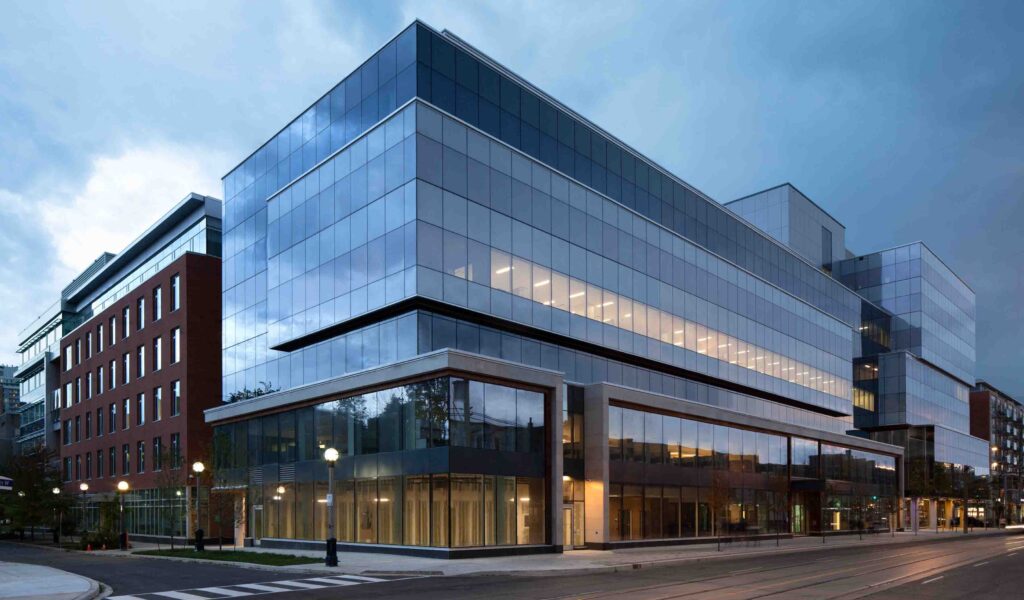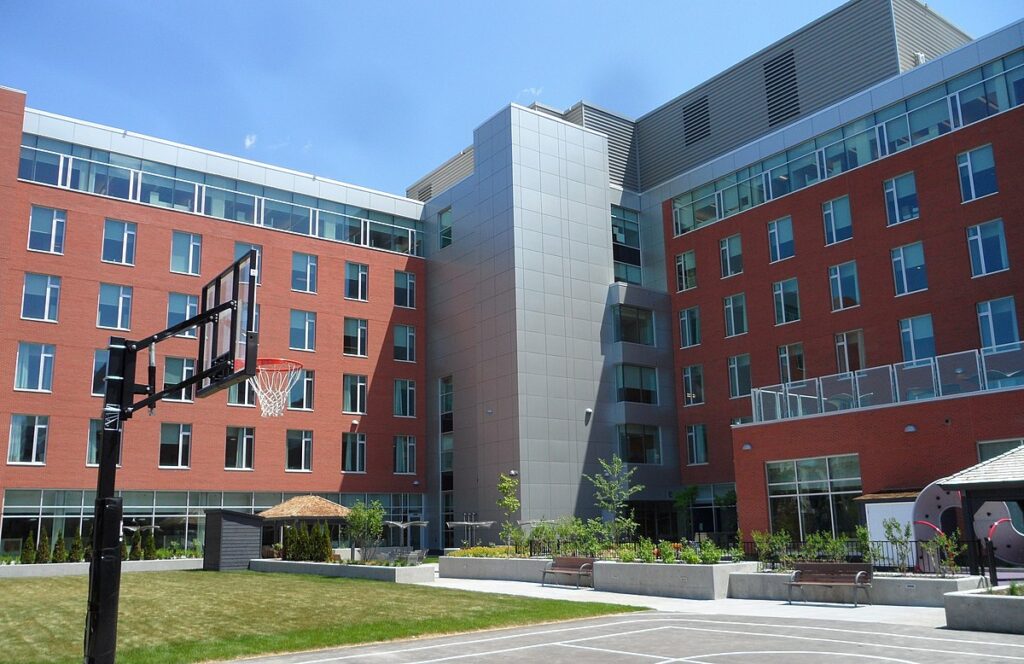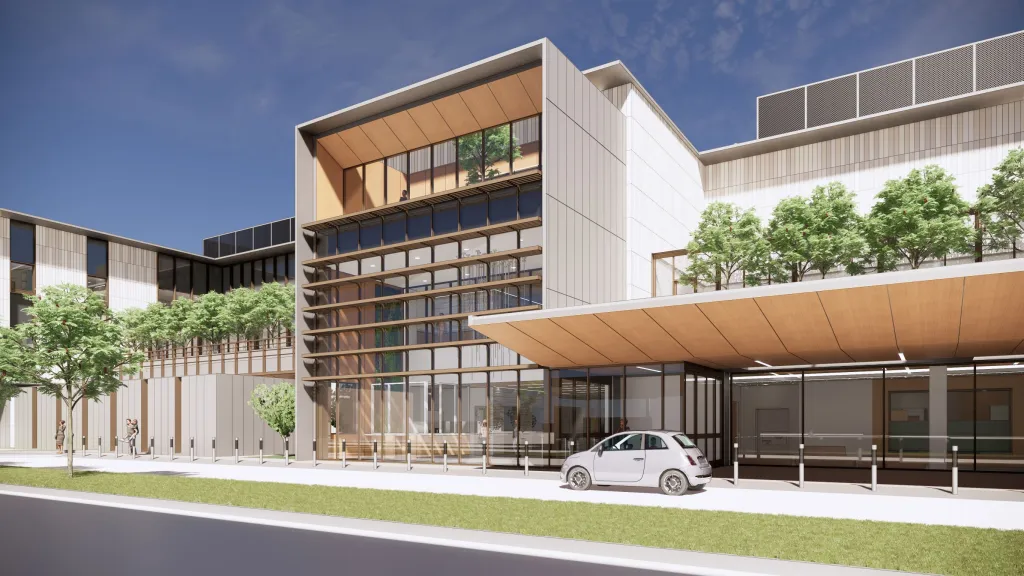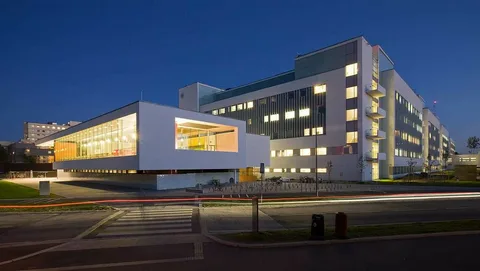Project Overview:
Hodgson Engineering Group played a key role in the Phase 1 Redevelopment of the Centre for Addiction and Mental Health (CAMH) in Toronto, Ontario. Our team was tasked with constructing a cutting-edge patient care and research facility, seamlessly integrating advanced infrastructure and technologies into the existing campus. The development focused on creating a healing and supportive environment for vulnerable mental health patients, ensuring their specific needs were addressed. Completed in 2020, the project met all safety, quality, and compliance standards, reflecting our dedication to providing top-tier construction services.
Key Focus Areas:
Supportive Environment: The design aimed to provide a safe, calming, and supportive space for patients. This was paramount, given the nature of the facility’s mental health services.
State-of-the-Art Facility: Our team worked to incorporate the latest technologies and infrastructure to meet the evolving needs of mental health care and research.
Timely Completion: Despite challenges, we ensured the project adhered to timelines, and Phase 1 opened on schedule in 2020, serving as a vital resource for the community.
Commitment to Safety and Quality: Every phase was executed with the highest standards of safety and quality in mind, ensuring patient well-being and long-term durability of the building.


Project Challenges:
Design and Construction of Specialized Spaces: One of the main challenges was designing and constructing a facility tailored specifically to the needs of mental health patients. The requirements for creating a safe and healing environment meant that careful attention was needed in the design of spaces that would foster comfort, privacy, and security while meeting the functional needs of patients and healthcare providers.
Integration with Existing Infrastructure: The redevelopment required seamless integration with the existing CAMH campus, which presented challenges in coordinating the new building’s design and infrastructure with the older structures. Careful planning and execution were required to avoid disrupting ongoing operations, including mental health care and research activities, during construction.
Safety and Compliance Standards: Given the sensitive nature of the project, strict adherence to safety regulations and compliance standards was essential. This included ensuring that the facility met all required building codes, health regulations, and accessibility guidelines, all while maintaining a secure and supportive environment for both patients and staff.
Logistical Coordination: Coordinating the delivery and installation of specialized equipment and materials for the construction of a mental health facility presented logistical challenges. Many of the technologies and infrastructure required careful handling and precise installation to ensure functionality and patient safety.
Minimizing Disruption to Ongoing Services: As CAMH continued its critical services during the redevelopment, minimizing disruption to the ongoing care and research activities was a priority. Ensuring that construction noise, dust, and interruptions were kept to a minimum required careful scheduling and effective communication with stakeholders to ensure that patient care was never compromised.
Adapting to Evolving Health and Safety Guidelines: The construction of a healthcare facility meant that Hodgson Engineering Group had to adapt to constantly evolving health and safety guidelines, especially in the context of the COVID-19 pandemic. The team had to implement enhanced safety measures to ensure the protection of workers on-site while also aligning with the latest health standards.
Time Sensitivity and Deadlines: The project had tight timelines for completion, especially since CAMH needed to open the new Phase 1 facility as soon as possible to accommodate the growing needs of mental health patients. This posed a challenge in maintaining both quality and safety while adhering to deadlines. Managing project timelines and resources efficiently required constant monitoring and flexibility.
Stakeholder Collaboration: Collaborating with numerous stakeholders, including mental health professionals, architects, and project managers, presented challenges in aligning everyone’s needs and expectations. The complexity of designing and building a state-of-the-art mental health facility required continuous communication and coordination to ensure all aspects of the project were carefully considered and executed.
Despite these challenges, the successful completion of Phase 1 of the CAMH Redevelopment reflects the commitment of Hodgson Engineering Group to providing high-quality, safe, and effective solutions for sensitive healthcare projects.


Final Result:
The successful completion of Phase 1 of the Centre for Addiction and Mental Health (CAMH) Redevelopment stands as a testament to Hodgson Engineering Group’ dedication to excellence in construction and our commitment to providing safe, functional, and innovative spaces for mental health care. Despite the challenges faced during the project, including the integration with existing infrastructure, adherence to strict safety standards, and ensuring minimal disruption to ongoing services, Hodgson Engineering Group delivered a state-of-the-art facility that exceeds expectations.
Key highlights of the final result include:
Timely Completion: Phase 1 was completed on schedule in 2020, allowing CAMH to open the new patient care and research facility without delay, fulfilling an urgent need for enhanced mental health services.
Safe and Healing Environment: The new building provides a healing and supportive environment specifically designed to meet the unique needs of mental health patients, incorporating elements that promote comfort, privacy, and security.
State-of-the-Art Technology: The facility features cutting-edge infrastructure and technology to support both patient care and mental health research, positioning CAMH as a leader in innovation and care for the mental health community.
Seamless Integration: The construction work was completed with minimal disruption to CAMH’s ongoing operations, ensuring that patient care continued smoothly throughout the project. The integration of new infrastructure into the existing campus was executed successfully without compromising the facility’s functionality.
Safety and Quality: Throughout every phase of the project, Hodgson Engineering Group maintained the highest standards of safety, quality, and compliance, ensuring the facility meets all required building codes, health regulations, and accessibility guidelines.
The completion of Phase 1 of the CAMH Redevelopment underscores Hodgson Engineering Group’ expertise in handling complex healthcare projects, and it marks a significant contribution to the mental health care sector. The new facility serves as a vital resource for both patient care and research, and it sets a high standard for future healthcare projects. We are proud to have been part of this impactful project and to have contributed to improving the lives of those who rely on CAMH’s services.